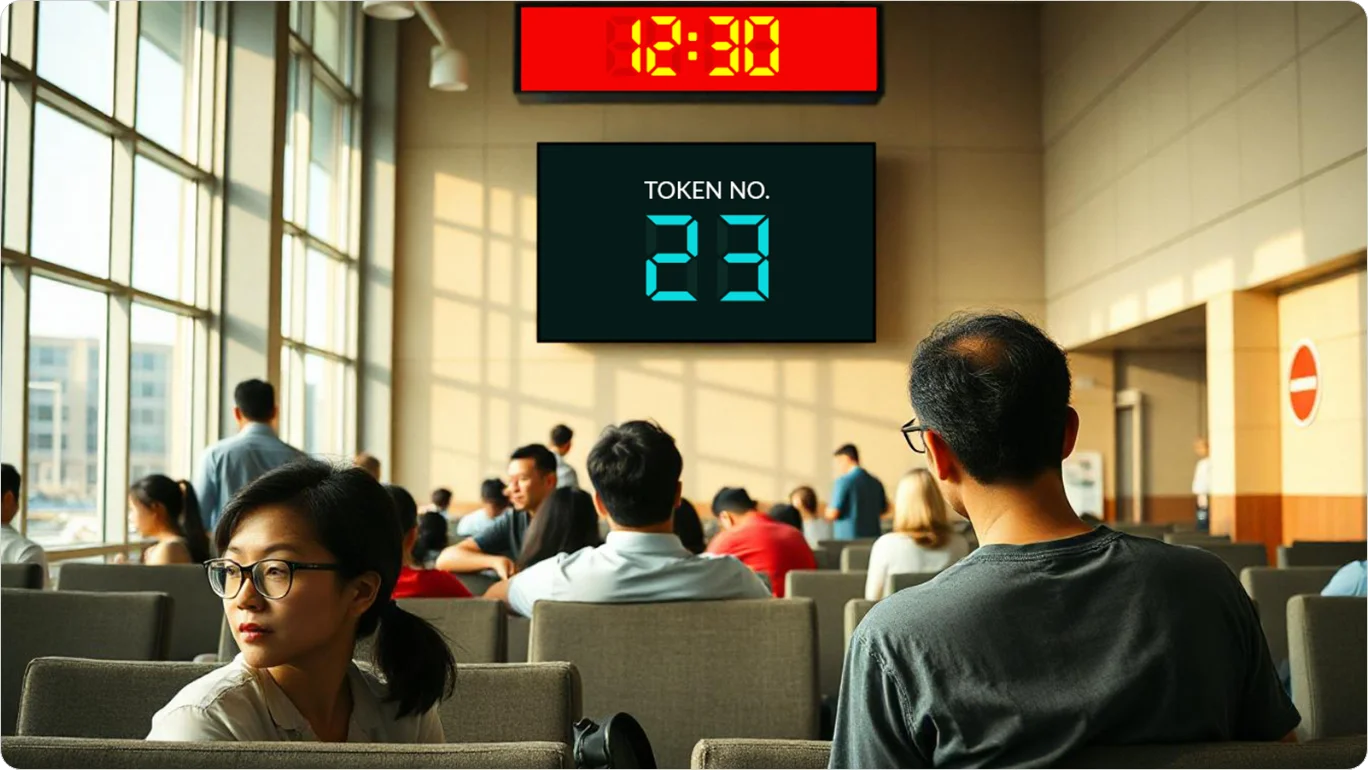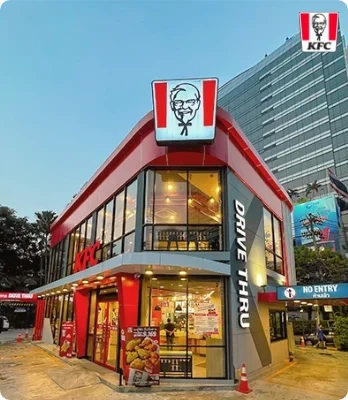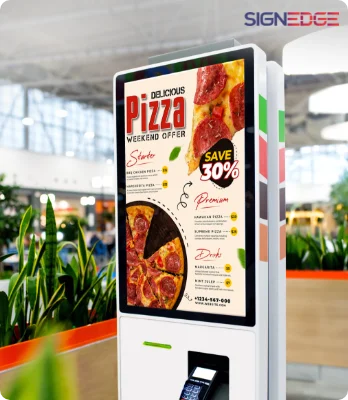
Industry:
Consumer DurablesProject
Introduction
In the fast-paced world of customer service, the efficiency and effectiveness of queue management systems (QMS) are paramount. Panasonic's Queue Management System stands as a testament to the power of digital transformation in enhancing customer experiences and operational excellence. This case study delves into the intricacies of Panasonic's QMS, showcasing how cutting-edge technology and innovative strategies can revolutionize customer interactions and streamline service delivery.
Objective

The primary objective of Panasonic's QMS is to transform the traditional queuing experience into a seamless, efficient, and customer-centric journey. This system is designed to manage the flow of visitors from their initial entry point to check-out, ensuring minimal wait times and a smooth visiting experience. The objectives include:
-
01/
Enhanced Customer Experience
Reducing wait times and improving queue management to provide a seamless visiting experience.
-
02/
Operational Excellence
Streamlining visitor flow to enhance process efficiency and operational effectiveness.
-
03/
Data-Driven Insights
Utilizing real-time data for performance insights, enabling informed decision-making and continuous improvement.
-
04/
Digital Engagement
Engaging with waiting customers through digital means, including smart notifications and digital signage.
-
05/
Customization and Flexibility
Allowing for tailored settings and functionalities to meet diverse customer and branch needs.

Project Challenges

Integrating Diverse Functionalities
The challenge was to integrate a wide array of functionalities - from online appointment booking, real-time wait time predictions, to digital signage engagement - into a cohesive and user-friendly system. Ensuring seamless interaction between these features while maintaining a high level of performance was crucial.

User and Token Management
Developing a robust user management system that could handle multiple user roles with varying access levels, along with a sophisticated token management system for queue handling, presented significant technical challenges.

Real-Time Data Handling and Analysis
The system required the capability to handle and analyze large volumes of real-time data to provide accurate wait time predictions, queue status updates, and comprehensive reporting.

Customization and Template Design
Creating a system that allowed for high levels of customization, including pre-defined templates and composite views, required a flexible and dynamic design approach.

Multi-Location and Multi-Service Management
Designing a system that could efficiently manage multiple branches, departments, and services, each with its own unique requirements, was a complex task that demanded a deep understanding of operational logistics.

Feedback and Notification Systems
Implementing an effective feedback management system and customizable notification system for various events posed challenges in terms of user interface design and backend integration.

Technology Integration
The integration of various technologies, such as web-based applications for real-time status checking, LED displays for queue information, and mobile device compatibility for notifications and status updates, was essential for the success of the system.
Solutions
The primary objectives for Revlon's digital transformation were:
Advanced Queue Algorithm for Efficient Visitor Management
Panasonic's QMS is powered by an advanced algorithm that optimizes the flow of visitors. This algorithm analyzes real-time data to predict wait times accurately and manage queues efficiently. It dynamically adjusts to varying visitor volumes, ensuring minimal wait times and a streamlined experience.
Secure, Transparent User and Token Management
The system features a secure and transparent user and token management framework. It allows for the generation, forwarding, and management of tokens with a clear audit trail. This framework is fortified with end-to-end encryption and robust firewall mechanisms to ensure data security and privacy.
Customizable Service and Department Creation
The platform offers flexible service and department creation tools, allowing Customer and Branch Admins to tailor services and departments as per their specific needs. This customization extends to assigning contact persons and services, ensuring a personalized and efficient service delivery.
Comprehensive Branch Management with Real-Time Analytics
Branch management is enhanced with real-time analytics, providing insights into visitor flow, service efficiency, and operational metrics. Branch admins can create new branches and counters, assign services, and set schedules, all backed by data-driven decision-making tools.
Intuitive Location and Composite View
The system provides an intuitive location view, presenting a complete hierarchy and location-wise data visualization. The composite view feature allows for the integration of multiple services in a single template, maintaining a consistent theme across locations.
Pre-Defined Templates for Rapid Deployment
To expedite deployment across various branches, the QMS includes a range of pre-defined templates. These templates allow for quick selection and customization of queue information displays, ensuring brand consistency and operational efficiency.
Detailed Reporting for Continuous Improvement
The QMS features a comprehensive reporting module that includes feedback, check-in, peak day/time, serving, and operator reports. These reports provide valuable insights for continuous improvement and operational excellence.
Customizable Notifications for Enhanced Communication
Custom notifications for various events like appointment creation, cancellation, and reminders enhance communication with customers. These notifications can be sent via email, phone, and WhatsApp, ensuring timely and effective communication.
Feedback Management for Customer-Centric Improvements
The feedback management system captures customer feedback in real-time, allowing admins to view and analyze feedback for continuous service improvement.
Real-Time Appointment Reports for Effective Scheduling
The system provides real-time appointment information, accessible branch-wise. This feature aids in effective scheduling and resource allocation.
Intelligent Queue Management with Real-Time Reports
The QMS generates real-time queue management reports, providing data on average wait times and visitor numbers. This intelligence is crucial for management teams to enhance counter services.
Real-Time Queue Status Display and Notifications
Staff can use desktop or mobile devices to call the next visitor, with counter LEDs displaying real-time ticket numbers and wait times. Visitors can check these displays or use their mobile devices to view the queue status, receiving alerts for upcoming appointments.
Queue Data Analysis for Operational Insights
The system's data analysis capabilities offer real-time reports on queue management, crucial for improving service delivery and operational efficiency.
Technological Integration and Scalability
Built on a microservices architecture, the QMS is highly scalable and modular. Containerization of each microservice ensures easy deployment and scalability, adapting to varying business needs.
Data Security and Privacy Compliance
Data security is a top priority, with regular security audits, secure data transmission protocols, and compliance with data protection regulations. Techniques like data anonymization are employed to safeguard user privacy.
Results
& Impact

Enhanced Customer Satisfaction
The implementation of Panasonic's QMS has significantly reduced wait times and improved the overall customer experience. Visitors now enjoy a more streamlined and efficient service, leading to higher satisfaction rates. The transparent process and real-time updates have contributed to a more relaxed and informed waiting experience.

Operational Efficiency
The QMS has streamlined visitor flow, leading to improved operational efficiency. Real-time data analytics and queue management have enabled branches to optimize staff allocation and service delivery, reducing bottlenecks and improving service times.

Data-Driven Decision Making
The comprehensive reporting and analytics capabilities of the QMS have empowered management teams with actionable insights. This data-driven approach has led to informed decision-making, enhancing service delivery and operational strategies.

Increased Engagement and Communication
Customizable notifications and digital signage integration have opened new channels for engaging with customers. This enhanced communication has not only improved the waiting experience but also provided opportunities for marketing and customer education.

Feedback-Driven Improvements
The feedback management system has provided valuable insights into customer preferences and areas for improvement. This continuous feedback loop has led to customer-centric enhancements and service refinements.

Scalability and Flexibility
The microservices architecture of the QMS has ensured scalability and flexibility, allowing the system to adapt to different branch sizes, service types, and customer volumes. This scalability has been crucial in maintaining performance levels across diverse operational environments.

Security and Compliance
The robust security framework of the QMS has ensured the protection of sensitive customer data, complying with data protection regulations. This has not only safeguarded customer information but also reinforced trust in Panasonic's services.

Technological Leadership
The successful deployment of the QMS has positioned Panasonic as a leader in digital transformation in the customer service domain. The innovative use of technology in enhancing customer experience has set a benchmark in the industry.
Project
Summary
The Panasonic Queue Management System has demonstrated significant results in enhancing customer satisfaction, operational efficiency, and data-driven decision-making. Its impact extends beyond improved service delivery to include increased customer engagement, better resource management, and reinforced security and compliance. The QMS stands as a testament to Panasonic's commitment to technological innovation and customer-centric service delivery.
More
Case Studies
Next Level Tech,
Engineered at the Speed of Now!
Are you in?
Let Neuronimbus chart your course to a higher growth trajectory. Drop us a line, we'll get the conversation started.




